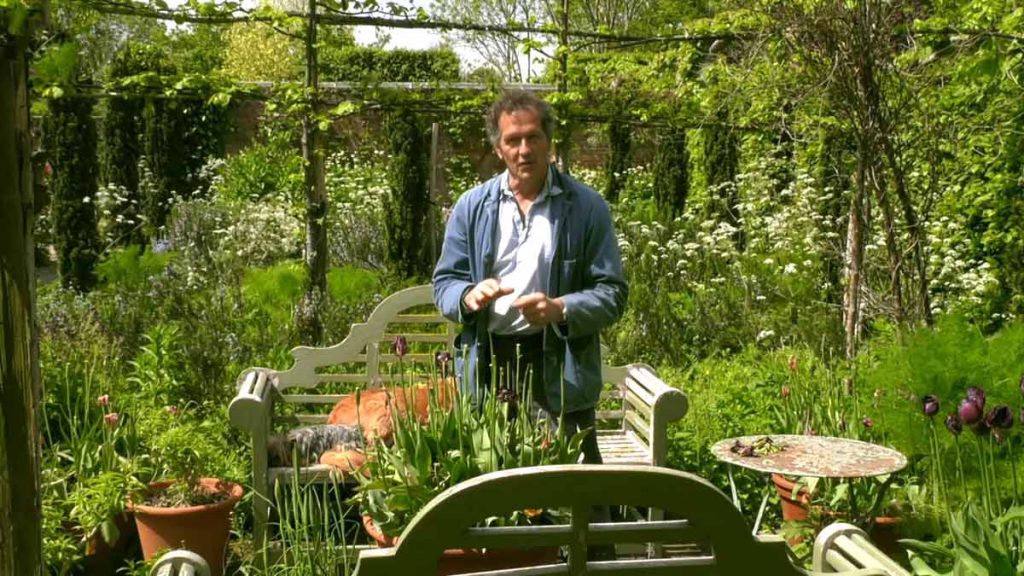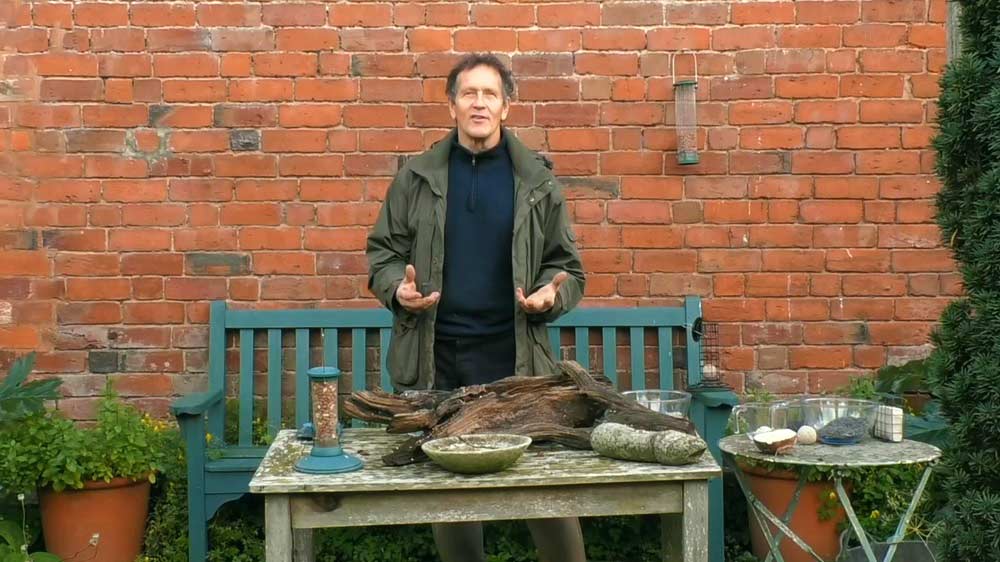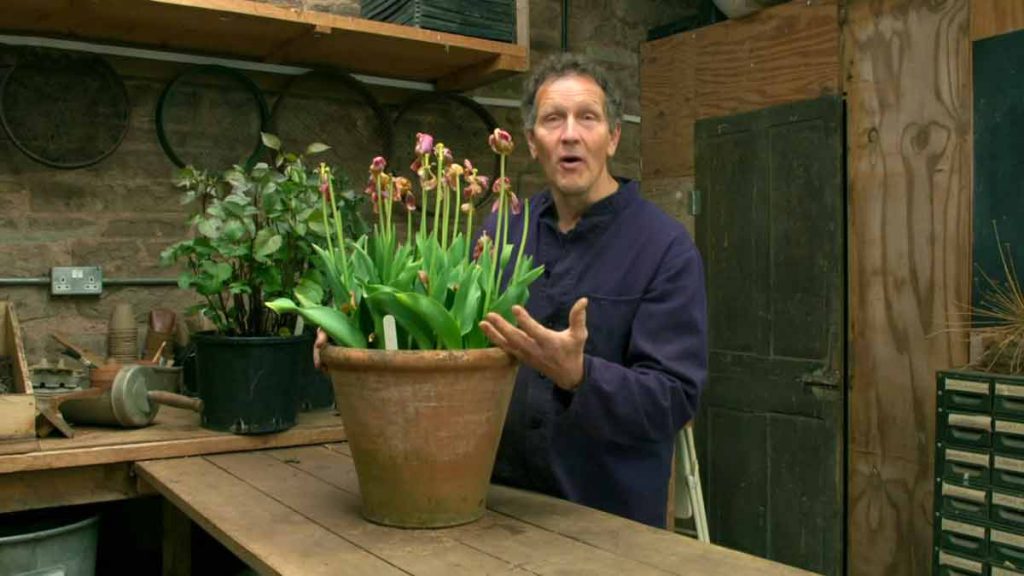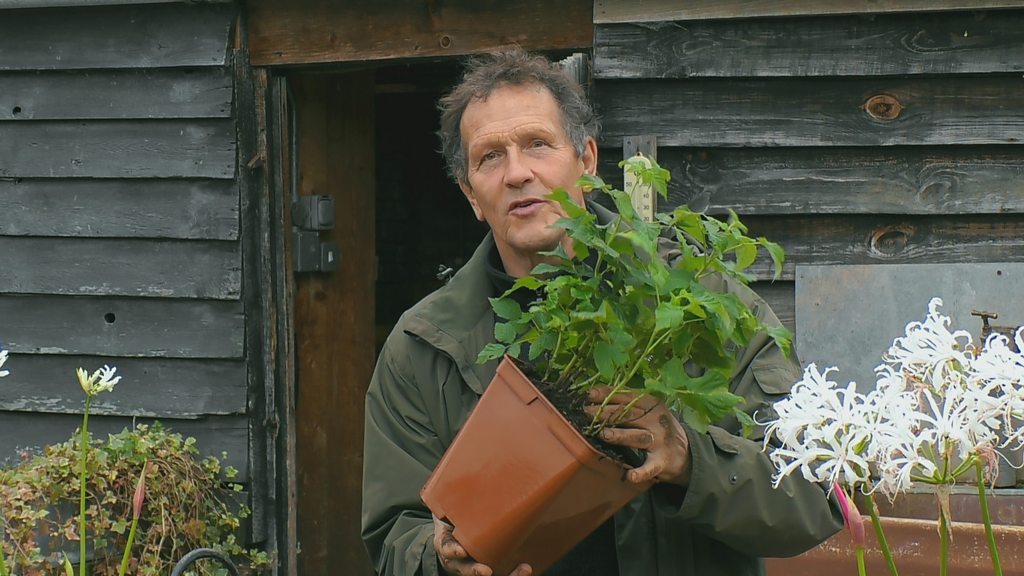Gardeners’ World 2021 episode 13: At Longmeadow, Monty turns his attention to containers, planting them up for drama and summer colour in the jewel garden and showing us how to repot citrus plants.
In Hampshire, Joe Swift meets the designer of an award-winning contemporary garden to explore the techniques and the plants she has used to seamlessly integrate both house and garden. Meanwhile, we catch up with the three extraordinary sisters from Dorset who we met last year to find out about a whole new growing project they have started.
In Cheshire, we visit a garden where lack of space has not deterred the gardener from packing it full with tropical plants, and in Staffordshire, we get expert growing tips from the holder of a national collection of one of summer’s most delicate flowers, the angel’s fishing rod. We also find out what our viewers have been getting up to in their gardens.
Gardeners’ World 2021 episode 13
Tulips
Tulips are amongst the most popular of bulbs, valued for their brilliant flower colours and shapes. Plant in autumn for a show of spring flowers. Choose from a large range to suit the situation.
Whether used in formal or informal beds and borders, tulips make ideal bedding plants combined with annual or biennial planting. Tulips can also be useful for containers, and some varieties can be naturalised in grass. Tulips grow best in fertile, well-drained soil in full sun, sheltered from strong winds. All dislike excessively wet conditions; this is particularly true with alpine species which require excellent drainage. Exceptions include Tulipa sprengeri, T. sylvestris and T. tarda which prefer a more moisture-retentive soil with partial shade.
Incorporate organic matter into the soil before planting to improve both clay and sandy soils, making them much more suitable for tulips. Coarse gravel can also help improve growing in clay soils. Apply Growmore or chicken manure pellets (70g per sq m or 2oz per sq yd) before planting to help nutrient-poor soils. A neutral to alkaline soil is preferred. Soils with a pH lower than 6.5 may need applications of lime.
How to plant up containers
Containers filled with seasonal or permanent plants are extremely versatile. They can brighten up a corner of the garden, provide handy herbs by the kitchen or make the entrance look welcoming. Yet, life in containers can be tough for plants, so choose the right compost and carry out regular maintenance to ensure they put on a good show.
Containers are the perfect home for colourful annuals and half-hardy perennials – both of which are sometimes called ‘patio plants’ or bedding. Most shrubs, climbers, herbaceous perennials, grasses and even trees can be grown in containers. Fruit and vegetables can be successful too, as can some roses.
Ornamental grasses – Gardeners’ World 2021 episode 13
The variations in colour and texture of ornamental grasses provide structure, movement and interest in planting schemes, even in the dead of winter. Usually partnered with late summer perennials, grasses provide a long season of interest.
Ornamental grasses are adaptable, reliable plants, easily cultivated in sun or shade with some thriving in both. Although ideally well-drained soils suit these plants, some will grow happily in moist or wet soils.
Espalier know-how
Training apples and pears as espaliers is a space-saving way of growing fruit on a wall or fence. They require little pruning once established and are attractive in blossom and fruit and architectural during winter. Ornamentals such as Pyracantha are sometimes trained as espaliers.
Firstly you need to establish a training system against a wall or fence. Erect horizontal wires 35-45cm (15-18in) apart between posts, or straining ‘eyes’ on walls or fences. Trees should be planted 3.75m-6m (12-20ft) apart, according to their vigour. See our advice in trees and shrubs: planting for more information on planting trees.
How to succeed with citrus – Gardeners’ World 2021 episode 13
Oranges, lemons and limes are great container specimens, making it easy to enjoy the flavour and sweet scent of citrus in any garden. Overwintering them successfully is easy in a frost-free place, such as a greenhouse or conservatory.
Citrus are frost tender plants and temperatures below 7°C (45°F) may cause damage or even death. For this reason, in most parts of the UK, it is best to grow citrus in containers that can be moved to a warmer position over winter.
They are quite hungry plants, so use nutrient-rich compost such as John Innes No 2, with the addition of 20 percent by volume of sharp sand or grit. Use ericaceous John Innes compost in areas where hard water has to be used for irrigation. There are also specially formulated citrus composts available. Repotting is best done in spring, using only the next size pot. In years when repotting is not necessary, remove the top 5cm (2in) of old compost in late spring and replace with fresh compost.
Plants can be placed outdoors in summer, from mid-June to late September, if sheltered from cold winds. At other times, keep them in a cool greenhouse or conservatory. Citrus are not ideal houseplants, as the heat and dry atmosphere can cause scorch.




